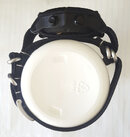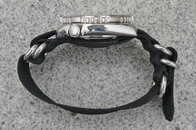... or "Why most NATO straps being sold are too short".
NATO straps have been a topic in a few threads (pros and cons; how to use them; how long they need to be), but I get the impression that it's not well known how to use one to full advantage as the design intends. Especially since they've become a fashion item, it's rare to see a manufacturer showing how to use one "properly", and therefore they make them too short, or even omit one or more rings. So for anyone who may find this useful and doesn't already know, here is how they were designed to be used:

No, I don't mean they are meant to be used on water bottles. Note that the strap is threaded through the watch pins and both rings of the short strap (as usual) but then threaded back through the ring closer to the watch. Why? So that when tighted on the wrist there is no tension at all on the watch pins. It doesn't matter how tightly you tension the wristband, the watch still rides tension-free on its own loop of the band. That was the point of the design: to eliminate (or at least vastly reduce) the most common failure point.
I'm not saying everyone should use a NATO strap (some folks really hate them). But if you do or are thinking of using one, consider taking full advantage of the design. This does take an additional 3 - 5 cm of strap length, so make sure yours is long enough for your purposes. (@stuartv I feel your pain: I ended up having one long enough for drysuit use custom made. I bought the webbing, harvested the hardware from a too-short strap, took it to a camping goods repair centre and had them sew it together.)
[[EDIT: Because a lot of manufacturers and vendors sell "NATO straps" that are missing one or more of the rings, keep in mind that to use it as described (and designed) make sure it has all 5 rings - 4 rings in addition to the buckle.]]
NATO straps have been a topic in a few threads (pros and cons; how to use them; how long they need to be), but I get the impression that it's not well known how to use one to full advantage as the design intends. Especially since they've become a fashion item, it's rare to see a manufacturer showing how to use one "properly", and therefore they make them too short, or even omit one or more rings. So for anyone who may find this useful and doesn't already know, here is how they were designed to be used:

No, I don't mean they are meant to be used on water bottles. Note that the strap is threaded through the watch pins and both rings of the short strap (as usual) but then threaded back through the ring closer to the watch. Why? So that when tighted on the wrist there is no tension at all on the watch pins. It doesn't matter how tightly you tension the wristband, the watch still rides tension-free on its own loop of the band. That was the point of the design: to eliminate (or at least vastly reduce) the most common failure point.
I'm not saying everyone should use a NATO strap (some folks really hate them). But if you do or are thinking of using one, consider taking full advantage of the design. This does take an additional 3 - 5 cm of strap length, so make sure yours is long enough for your purposes. (@stuartv I feel your pain: I ended up having one long enough for drysuit use custom made. I bought the webbing, harvested the hardware from a too-short strap, took it to a camping goods repair centre and had them sew it together.)
[[EDIT: Because a lot of manufacturers and vendors sell "NATO straps" that are missing one or more of the rings, keep in mind that to use it as described (and designed) make sure it has all 5 rings - 4 rings in addition to the buckle.]]






